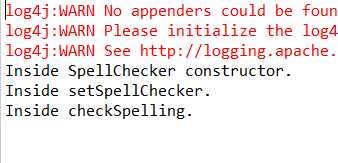Spring(五)之Bean定義繼承和依賴註入
一、Bean定義繼承
bean定義可以包含許多配置信息,包括構造函數參數,屬性值和特定於容器的信息,例如初始化方法,靜態工廠方法名稱等。
子bean定義從父定義繼承配置數據。子定義可以根據需要覆蓋某些值或添加其他值。
Spring Bean定義繼承與Java類繼承無關,但繼承概念是相同的。您可以將父bean定義定義為模板,其他子bean可以從父bean繼承所需的配置。
使用基於XML的配置元數據時,可以使用parent屬性指定子bean定義,並將父bean指定為此屬性的值。
演示示例:
(1)編寫HelloWorld.java
package com.tutorialspoint; publicclass HelloWorld { private String message1; private String message2; public void setMessage1(String message){ this.message1 = message; } public void setMessage2(String message){ this.message2 = message; } public void getMessage1(){ System.out.println("World Message1 : " + message1); } public void getMessage2(){ System.out.println("World Message2 : " + message2); } }
(2)編寫HelloIndea.java
package com.tutorialspoint; public class HelloIndia { private String message1; private String message2; private String message3;public void setMessage1(String message){ this.message1 = message; } public void setMessage2(String message){ this.message2 = message; } public void setMessage3(String message){ this.message3 = message; } public void getMessage1(){ System.out.println("India Message1 : " + message1); } public void getMessage2(){ System.out.println("India Message2 : " + message2); } public void getMessage3(){ System.out.println("India Message3 : " + message3); } }
(3)編寫MainApp.java
package com.tutorialspoint; import org.springframework.context.ApplicationContext; import org.springframework.context.support.ClassPathXmlApplicationContext; public class MainApp { public static void main(String[] args) { ApplicationContext context = new ClassPathXmlApplicationContext("Beans.xml"); HelloWorld objA = (HelloWorld) context.getBean("helloWorld"); objA.getMessage1(); objA.getMessage2(); HelloIndia objB = (HelloIndia) context.getBean("helloIndia"); objB.getMessage1(); objB.getMessage2(); objB.getMessage3(); } }
(4)Beans.xml
<?xml version = "1.0" encoding = "UTF-8"?> <beans xmlns = "http://www.springframework.org/schema/beans" xmlns:xsi = "http://www.w3.org/2001/XMLSchema-instance" xsi:schemaLocation = "http://www.springframework.org/schema/beans http://www.springframework.org/schema/beans/spring-beans-4.0.xsd"> <bean id = "helloWorld" class = "com.tutorialspoint.HelloWorld"> <property name = "message1" value = "Hello World!"/> <property name = "message2" value = "Hello Second World!"/> </bean> <bean id ="helloIndia" class = "com.tutorialspoint.HelloIndia" parent = "helloWorld"> <property name = "message1" value = "Hello India!"/> <property name = "message3" value = "Namaste India!"/> </bean> </beans>
(5)運行MainApp.java中的main方法

二、依賴註入
每個基於Java的應用程序都有一些對象可以協同工作,以呈現最終用戶所看到的工作應用程序。在編寫復雜的Java應用程序時,應用程序類應盡可能獨立於其他Java類,以增加重用這些類的可能性,並在單元測試時獨立於其他類測試它們。依賴註入(或稱為布線)有助於將這些類粘合在一起,同時保持它們的獨立性。
依賴註入常用兩種形式:
1.set註入(比較常用)
2.構造函數註入
set註入示例:
(1)編寫TextEditor.java
package com.tutorialspoint; public class TextEditor { private SpellChecker spellChecker; // a setter method to inject the dependency. public void setSpellChecker(SpellChecker spellChecker) { System.out.println("Inside setSpellChecker." ); this.spellChecker = spellChecker; } // a getter method to return spellChecker public SpellChecker getSpellChecker() { return spellChecker; } public void spellCheck() { spellChecker.checkSpelling(); } }
(2)編寫SpellChecker.java
package com.tutorialspoint; public class SpellChecker { public SpellChecker(){ System.out.println("Inside SpellChecker constructor." ); } public void checkSpelling(){ System.out.println("Inside checkSpelling." ); } }
(3)編寫Beans.xml
<?xml version = "1.0" encoding = "UTF-8"?> <beans xmlns = "http://www.springframework.org/schema/beans" xmlns:xsi = "http://www.w3.org/2001/XMLSchema-instance" xsi:schemaLocation = "http://www.springframework.org/schema/beans http://www.springframework.org/schema/beans/spring-beans-4.0.xsd"> <!-- Definition for textEditor bean using inner bean --> <bean id = "textEditor" class = "com.tutorialspoint.TextEditor"> <property name = "spellChecker"> <bean id = "spellChecker" class = "com.tutorialspoint.SpellChecker"/> </property> </bean> </beans>
(4)編寫MainApp.java
package com.tutorialspoint; import org.springframework.context.ApplicationContext; import org.springframework.context.support.ClassPathXmlApplicationContext; public class MainApp { public static void main(String[] args) { ApplicationContext context = new ClassPathXmlApplicationContext("Beans.xml"); TextEditor te = (TextEditor) context.getBean("textEditor"); te.spellCheck(); } }
(5)運行MainApp.java中的main方法

2.註入集合
Spring提供四種集合註入方式:
(1)Set;(2)List;(3)Map;(4)Props;
演示示例如下:
(1)編寫JavaCollection
package com.tutorialspoint; import java.util.*; public class JavaCollection { List addressList; Set addressSet; Map addressMap; Properties addressProp; // a setter method to set List public void setAddressList(List addressList) { this.addressList = addressList; } // prints and returns all the elements of the list. public List getAddressList() { System.out.println("List Elements :" + addressList); return addressList; } // a setter method to set Set public void setAddressSet(Set addressSet) { this.addressSet = addressSet; } // prints and returns all the elements of the Set. public Set getAddressSet() { System.out.println("Set Elements :" + addressSet); return addressSet; } // a setter method to set Map public void setAddressMap(Map addressMap) { this.addressMap = addressMap; } // prints and returns all the elements of the Map. public Map getAddressMap() { System.out.println("Map Elements :" + addressMap); return addressMap; } // a setter method to set Property public void setAddressProp(Properties addressProp) { this.addressProp = addressProp; } // prints and returns all the elements of the Property. public Properties getAddressProp() { System.out.println("Property Elements :" + addressProp); return addressProp; } }
(2)編寫Beans.xml
<?xml version = "1.0" encoding = "UTF-8"?> <beans xmlns = "http://www.springframework.org/schema/beans" xmlns:xsi = "http://www.w3.org/2001/XMLSchema-instance" xsi:schemaLocation = "http://www.springframework.org/schema/beans http://www.springframework.org/schema/beans/spring-beans-4.0.xsd"> <!-- Definition for javaCollection --> <bean id = "javaCollection" class = "com.tutorialspoint.JavaCollection"> <!-- results in a setAddressList(java.util.List) call --> <property name = "addressList"> <list> <value>INDIA</value> <value>Pakistan</value> <value>USA</value> <value>USA</value> </list> </property> <!-- results in a setAddressSet(java.util.Set) call --> <property name = "addressSet"> <set> <value>INDIA</value> <value>Pakistan</value> <value>USA</value> <value>USA</value> </set> </property> <!-- results in a setAddressMap(java.util.Map) call --> <property name = "addressMap"> <map> <entry key = "1" value = "INDIA"/> <entry key = "2" value = "Pakistan"/> <entry key = "3" value = "USA"/> <entry key = "4" value = "USA"/> </map> </property> <!-- results in a setAddressProp(java.util.Properties) call --> <property name = "addressProp"> <props> <prop key = "one">INDIA</prop> <prop key = "one">INDIA</prop> <prop key = "two">Pakistan</prop> <prop key = "three">USA</prop> <prop key = "four">USA</prop> </props> </property> </bean> </beans>
(3)編寫MainApp.java
package com.tutorialspoint; import org.springframework.context.ApplicationContext; import org.springframework.context.support.ClassPathXmlApplicationContext; public class MainApp { public static void main(String[] args) { ApplicationContext context = new ClassPathXmlApplicationContext("Beans.xml"); JavaCollection jc=(JavaCollection)context.getBean("javaCollection"); jc.getAddressList(); jc.getAddressSet(); jc.getAddressMap(); jc.getAddressProp(); } }
(4)運行MainApp.java中的main方法
結果如下:

Spring(五)之Bean定義繼承和依賴註入
